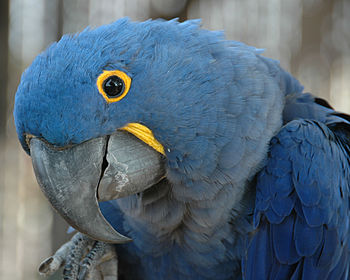 |
| Hyacinth Macaw (Anodorhynchus hyacinthinus) showing side of head and neck. (Photo credit: Wikipedia) |
Characterized by their playful nature, Macaw parrots have earned a hefty reputation of being one of the most interesting birds because of their high intelligence and beauty. Hailing from South and Central America as well as from the Caribbean islands, macaw parrots have been legendary for possessing a unique personality and lovable characteristics, which makes them loyal and great companion parrots.
But, despite of its superb potentials, most people say that Macaw parrots are not good pets because they possess destructive tendencies, raucousness, demanding, and very noisy large birds.
Macaw parrots are not among those most favorite parrot pets because they screech so loud that most owners cannot tolerate. Aside from being creating loud noise, macaw parrots also have a reputation of being very demanding birds.
If you are planning to purchase a Macaw parrot for a pet bird, you have to have a great deal of knowledge and research about the nature and characteristic of macaw parrots species so you would have an idea how to take care of them. Although this parrot specie is not the most suitable parrot pet an owner can have, these large birds can live from 25 to 80 years and even beyond if taken care of properly.
Understanding Macaw parrots
Among the so many species of macaw parrots, the most popular include the Blue and Gold Macaw, Blue and Yellow Macaw which are the most available and popular kind of macaw parrot for being adaptable, playful, curious, and fun loving;
Scarlet Macaw, Red and Yellow Macaw which are considered as among the top ten of the worlds most beautiful parrots; Greenwing Macaw, Maroon Macaw, Red and Green Macaw, Red and Blue Macaw which are extremely intelligent and inquisitive ones;
Military Macaw that has fine talking skills and a pleasant behavior;
Red Fronted Macaw, Red Crown or Crowned Macaw which are among the sweetest and amiable parrots;
Hyacinthine or Hyacinth Macaw which is the largest among the parrot family;
Hahn's Down which are full blooded Macaws which are talkative and thrive in attention and Severe Macaw which is an uncommon pet bird because of its small size.
Here are some points to consider before buying a macaw parrot:
1. Talking Ability. These parrots are not considered excellent talkers but have high capabilities for speech and can be very good at language interaction.
2. Personality. Macaw parrots are among the most demanding pet parrots there are so you better make sure that you can spend enough time to interact with your parrot. Because of its violent tendencies, owning a macaw parrot is not advisable for parents that have little children.
3. Basic necessities. Since they can be quite demanding and destructive if not given the proper care, you must make sure that you can provide the things the macaw parrot might need such as toys, acrobatics and love ropes, big and secure cage and proper diet.
4. Biting and Taming. Because of its complex personality, macaw parrots can be extremely aggressive if not handled properly. Bear in mind that macaw parrots’ temperament changes as time goes by so you better brace yourself for the best or the worst attitude this bird can exhibit.

